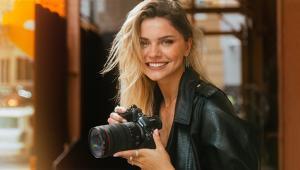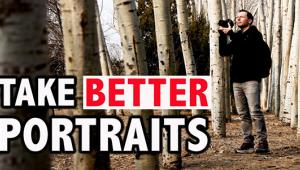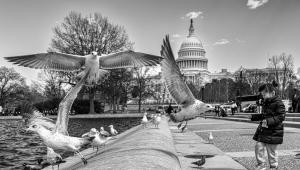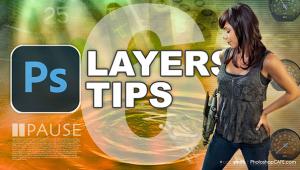Turning Portraits Into Profits: How to Run a Portrait Photography Business

As a photo rep, I have always had great admiration for the portrait photographer. You are catching people at their worst (“I hate having my picture taken!”) and at their best (“Yes, this is really who I am!”). Whether it is a toddler, high school senior, or CEO, you are responsible to keep people calm, work fast, overcome technical and travel obstacles, and manage all the details of composition and lighting. In this column, we talk about all these issues as well as marketing your portrait photography business, the skills required for business success. Special thanks to our contributing photographers: Rick Dahms, Omayra Espino-Vázquez, Robert Houser, David Neff, Sara Press, and Michael Schmitt.
Shutterbug: What do you see as the most important difference between consumer and commercial portrait photography assignments? Not only the technical but also the business or marketing issues.
Michael Schmitt: The difference in consumer and commercial photography is in the objective of the final images. I see consumer portraits as trying to get the most flattering image of your client; something they can feel good about sharing with family and friends. With commercial portraits the photographer is trying to tell a story; capture their subject in a tone that is fitting for the story being written about the subject. Therefore, a photographer doing consumer portraits needs to be able to bring out the best in the person(s), bringing energy to the portrait session. The commercial photographer has to be able to follow creative direction given to them by their client. This creative direction can dictate how they relate to their subject. Both consumer and commercial photographers need to know their gear backward and forward before doing their portrait assignment.
Omayra Espino-Vázquez: I feel that consumer portraits are more about the relationship and personality of the person in front of your lens. In terms of marketing, the best way to reach consumers is to let them know you at a “friend” level. It is also all about the experience that you can bring your clients. People react to emotions and experiences, so connecting at this level is as important as delivering great images.
Sara Press: With consumers, there is a big spectrum ranging between people who are most concerned about price and those who are more concerned with quality (i.e., talent and reliability). On the commercial side, reliability is tantamount to talent and style. That’s not to say that editorial and commercial clients aren’t often on tight budgets, they let you know when they are, but they aren’t going to call someone who they don’t see as rock solid.

SB: What skills or areas of expertise (other than photography) do you think a portrait photographer has to develop for a successful business?
Rick Dahms: You have to honestly like people. You need to be interested in them and curious about their lives. In a business like this, everything is personal. Another is negotiation. Finding the number and terms that get you as much as possible but leaves your client feeling like they got a good deal. Finally, research. Research your client, research your subject—a simple Google search, cruise their LinkedIn and Facebook pages. Know who you’re dealing with.
Sara Press: I am always amazed at how many different hats a freelance photographer needs to wear. But the main one is definitely people skills. It’s critical. You need to be able to get yourself in front of potential clients, then convince them that you will do a good job for them. And then in order to do a good job, you need to make your subject feel relaxed and have fun while you are shooting.
Robert Houser: I’m a strong believer in observation and communication skills. There is nothing that can break someone out of their day like a perfectly phrased observation about them, the room, or their past. I will often research the person I’m photographing beforehand to find something, some clue, or what I consider a “way in.” The perfect clue might be the school they went to, someone they reference on their LinkedIn profile, where they used to work, or even the company’s stock price recent history. I also look for things when I’m scouting—I tell people that I notice stuff—a small picture of grandkids behind their desk, a jacket in a hallway, or something I can use in an opening conversation.
Michael Schmitt: You have to be expert at understanding people! You need to understand how to make people feel comfortable, feel good about themselves, and get them to relax in front of the camera. This might be done through talking with your subject before and/or during the portrait session. Giving direction, or not, during the shoot. This all needs to be done fast and seamlessly from the moment you make contact with your subject on the day of the shoot.

SB: When you are looking at your overall marketing efforts, what is working best for you now?
Rick Dahms: Obviously, you have to have a website. You’re not a photographer if you don’t have a website. Everything else is a crapshoot. Twenty years ago, sourcebooks worked. Fifteen years ago, direct mail worked. Ten years ago, e-mail blasts worked. Five years ago it was blogs. Now it’s social media, which demands a level of narcissism that I can’t quite reach. Probably an age factor. What’s working for me is referrals. Relationships with clients and subjects are far and away my biggest source of new business.
Sara Press: My best source of clients has always been word of mouth, built by years of sending quality photos out into the world, and, at the beginning when I was young with less overhead and could afford the time, shooting for fun on projects with friends that blossomed into other things. But it’s hard to cultivate word of mouth, it just grows naturally on its own. I have never had much success with advertising. And I don’t have much time these days to spend on social media. I hear Instagram works really well for some people. But most of my cold leads now are from Yelp and ASMP’s “Find A Photographer.”
Michael Schmitt: By far the most important tool for marketing that every photographer should have is a visually appealing website. No matter what else I do for marketing, I know I will be judged by my website. My marketing efforts ultimately try to drive people there to take the time to look at my work. I feel being present on social media, sending e-mail blasts and direct mail have all become important in reminding my clients and prospective clients of my work.
Omayra Espino-Vázquez: The marketing that I use is my website and if I have any special events I will use direct mailers. I do not use ads because in my opinion they do not work for consumer portraits. Social media is still something that I do, but I do not put much effort in it. For e-mail blasts and blogging I usually focus on events and uplifting messages that I can send my clients that will brighten their day or give them information that is useful for them. The most effective marketing strategy has been word of mouth. Create an amazing experience for your client and they will not stop talking about how great you are.
Robert Houser: I think it’s absolutely impossible to say one method definitively works better than another. I have gotten a job off Instagram when I had only 100 followers, and have had nothing from thousands of e-mail campaigns. On the other hand, I’ve had new clients that I’ve never talked to mention how they have gotten my e-mailers for years and remembered them. There is no way you will know what will bring in that big job. Should you do all of them? I think you need to be honest with yourself—what are you going to be able to commit to both economically and time-wise? If you do a half-assed job on creation of any campaign, it’s not going to pay off.
David Neff: It’s not any one thing I can pinpoint but a presence and brand recognition will do it. Nobody picks up the phone anymore unless they know who you are or you’re handing out money.


SB: What is the best “war story” portrait photo assignment you have had? Maybe something that was a real learning experience you can share with our readers.
David Neff: A magazine hired me to shoot Donald Trump with Jr. and Ivanka a few years ago. I had a decent amount of time with them, they seemed friendly on introduction, but when the camera came out they began to tag team me to take control of the lens length, angle, and other details. After a few rounds of keeping them confused with blinding strobes, I was able to get the angle, lens, and image I wanted in the first place without them walking out two minutes into our 20 minutes together. They were relentless but I prevailed! A day after publication, I got a call from one of Trump’s assistants asking for a print, apparently they loved the image. I told them an 8x10 was $200, they never called back.
Rick Dahms: I took an iconic photo of a goatherd standing in her herd of goats. A photo editor saw it and asked if I could shoot a similar photo of a woman running a pig sanctuary. I said, “Of course!” For the goat shot, I’d put the goatherd where I wanted her to stand and spread some grain on the ground around her. The goats gathered around her and I shot. Easy. So I figured I’d do the same thing with the pigs. Out at the sanctuary, our subject said that the pigs were all out in the woods but if we had some food, they’d come. I’d brought 25 pounds of carrots so we drove out into the field next to the woods and set up for our shot. Once the lighting was set, I tore open the bag of carrots and started shaking them out in a circle around our subject. This took about four seconds. Then she said, quietly, “Oh, I wouldn’t have done that.” The pigs must have been watching from the edge of the woods because they exploded out of the trees like something out of a Mad Max movie.

Goats are smallish, mostly gentle, docile animals. Pigs, excited by free carrots, are more like rabid pickup trucks. We could feel the ground moving before they’d made it halfway to us. These were big pigs, some four feet at the shoulder, over 500 pounds, and they were moving much faster than I thought pigs could move. Our subject started running. My assistant started running—with the lights, God bless her. I climbed up on the truck as the pigs collided over the carrots in what looked like a combination of waves smashing over rocks and the best demolition derby ever. Using their snouts, the biggest pigs were tossing the simply large pigs around like beanbags and, once tossed, those pigs would immediately jump to their feet and charge back into the mayhem. See, these weren’t just big pigs—this was a sanctuary for abused and abandoned pigs. These were pigs with issues. When the carrots were gone and the riot had subsided, somehow with no injuries, we regrouped, broke out a battery light on a stick, and reapproached the project with a gentle, respectful manner more in tune with the specific personality traits of the pigs. We went to them. Cautiously.
Resources
Rick Dahms: rickdahms.com
Omayra Espino-Vázquez: spinophoto.com
Robert Houser: roberthouser.com
David Neff: davepix.com
Sara Press: sarapress.com
Michael Schmitt: michaelschmitt.com
- Log in or register to post comments

















































